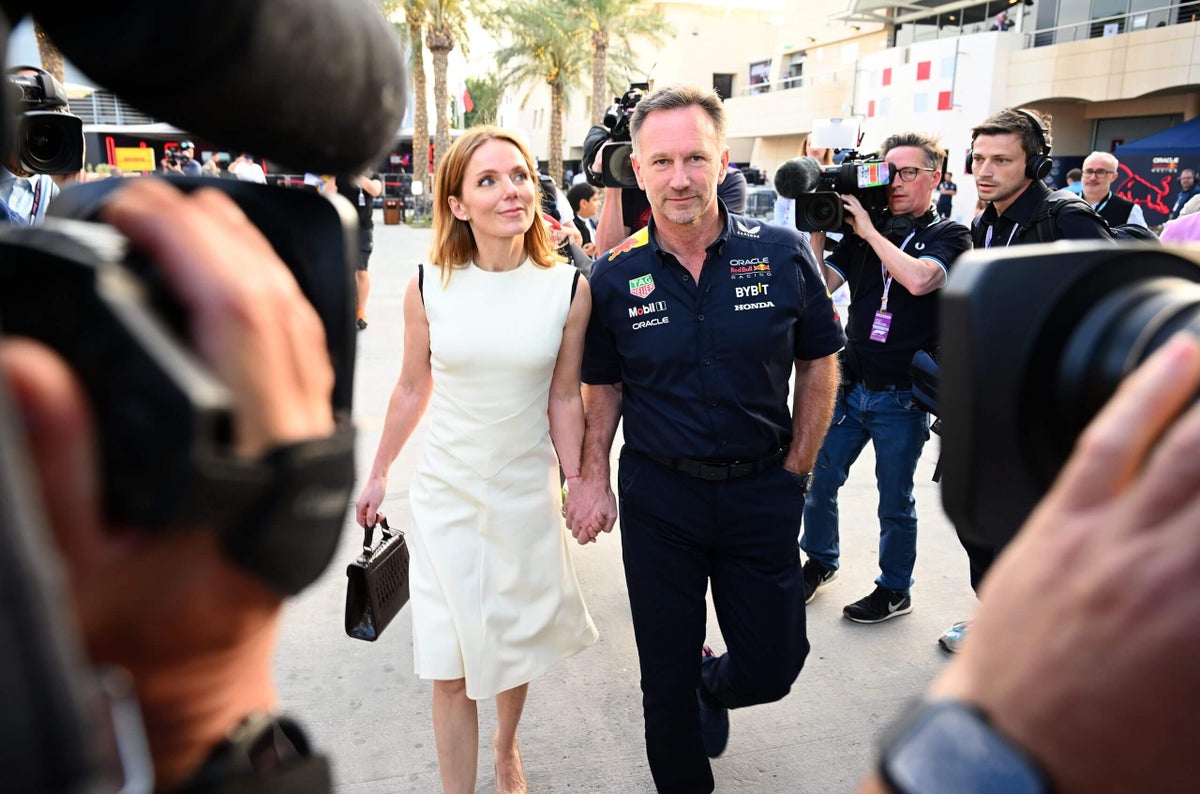Christian Horner has been one of the most recognizable and public faces in recent Formula One history.
Between his leadership of Red Bull Racing, his regular presence on Netflix docuseries “Drive to Survive” and his marriage to former Spice Girl Geri Halliwell, Horner has been front and center of the sport.
That all came to a sudden end on Wednesday when Red Bull announced Horner had been relieved of his duties after more than 20 years in charge. Horner has dedicated the majority of his adult life to his work at Red Bull. He took charge of the team in January 2005 at the age of 31, and remains the youngest team principal in F1 history, having turned to team management after seeing his own dreams of making it as a driver ultimately fade.
Now, for the first time in 20 years, Horner finds himself away from the frontlines of F1, left to reflect on a career in service to Red Bull.
In another life, instead of being on the pit wall as team principal, Horner could have been the one lining up on the grid for the start of each F1 grand prix.
Horner rose through the ranks of junior motorsport in go-karting and domestic championships in the UK, earning a scholarship and winning a handful of races before eventually getting to Formula 3000, the final step before F1 and equivalent to what is now Formula Two. Instead of signing for another team, Horner decided to set up his own outfit called Arden in 1997, so that he could have some assets around him.
He scored just a single point in two F3000 seasons in 1997 and 1998. He admitted in an appearance on the High Performance Podcast in 2021 that he first realized the drivers around him were simply better as early as Formula Three, but the real penny-drop moment came during an F3000 test when he saw Juan Pablo Montoya, a future F1 driver and two-time Indianapolis 500 winner, going through a high-speed corner.
“I could just see the angle this car was at, the commitment that he had,” Horner told F1’s Beyond the Grid podcast in 2018.
“The rim is trying to push its way through the tire, and he just kept this thing absolutely planted. I just knew, ‘I can’t do that’. My foot and brain, there’s something between them that’s saying ‘don’t do it!’”
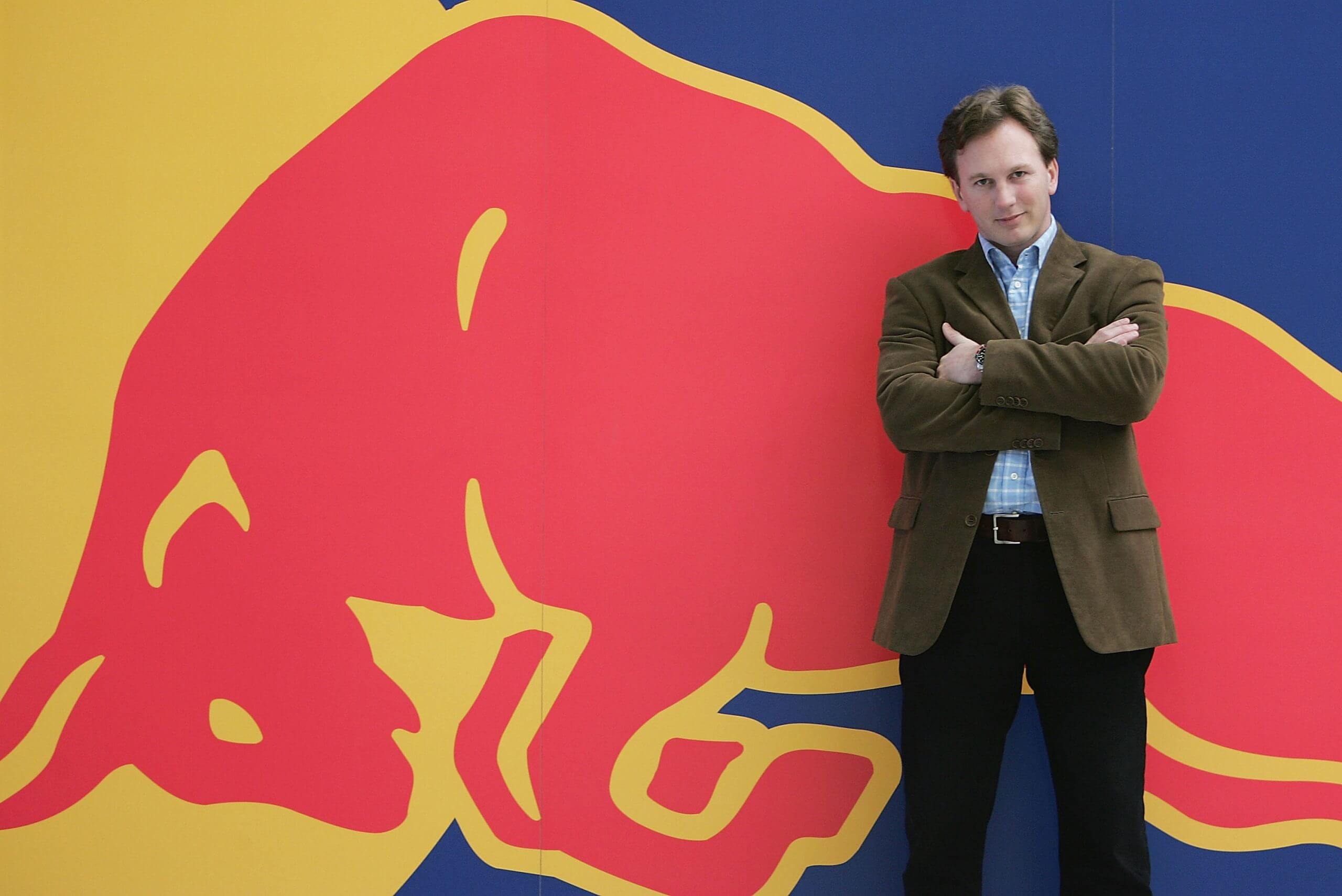
Christian Horner at Red Bull’s headquarters in the English town of Milton Keynes in January 2005. (Mark Thompson / Getty Images)
The fact he owned Arden made Horner’s transition into team management easy. He signed drivers and went on to win three consecutive F3000 titles from 2002 to 2004. Even at the age of 31, he felt ready to make the step to F1.
And Horner had already made an important contact for his future move to Red Bull back when he was racing.
When he was setting up Arden, he needed to buy a trailer and found one for a reasonable price being sold by a Dr Helmut Marko in Austria. Horner didn’t know much about Marko, only that he was a former racing driver who had won the 24 Hours of Le Mans with Porsche in 1971, and had his F1 career cut short by an accident where he lost sight in one eye after a rock pierced his helmet. Horner flew to Austria to meet Marko and agree on a price on the trailer, starting a relationship that would last almost 30 years.
In 2004, Red Bull was starting to explore moving into F1 with its own team, making Marko, who oversaw its young driver program, a key point of contact. Horner was also looking at taking Arden into F1 at the time, holding talks with Eddie Jordan about buying his eponymous, cash-strapped team. But after Marko introduced Horner to Dietrich Mateschitz, the billionaire co-founder of Red Bull, he was offered the top job at its new team, Red Bull Racing, in late 2004.
On Beyond the Grid, Horner recalled it was a “very low offer” from Mateschitz, but one that came with a bonus per point scored. As Jaguar in 2004, the team had scored nine points all season. On debut, Red Bull scored 12 points in Australia in 2005; a positive sign of greater things to come.
The vibe surrounding Red Bull when its team debuted in F1 was all about fun.
Its motorhome, called the ‘Energy Station,’ had an open-door policy to the entire paddock (something that has since ended, coming in line with other teams). At Monaco in 2005, the team ran a Star Wars-themed livery to promote the new movie and even made Stormtrooper-style helmets for its pit crew.
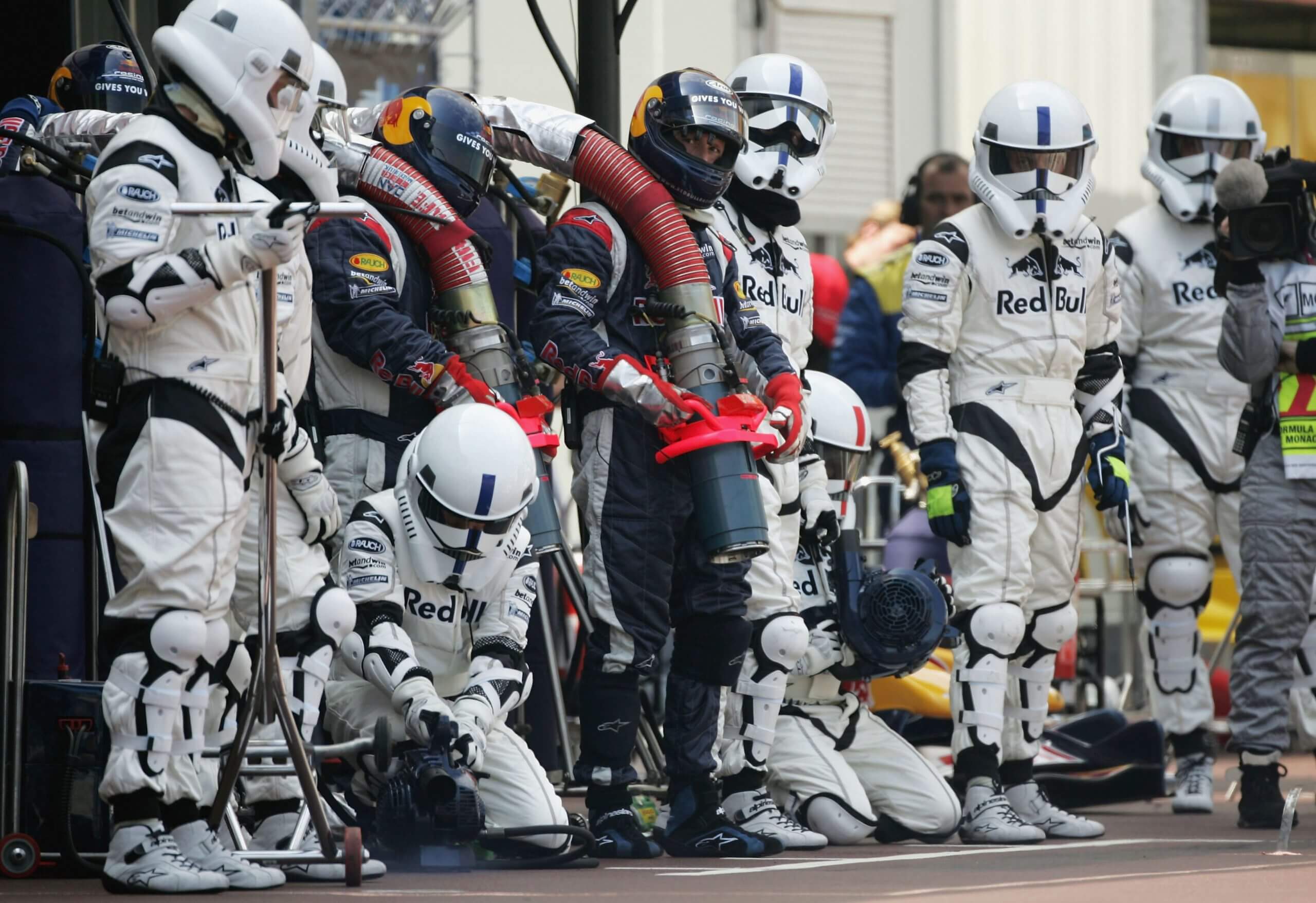
The Red Bull Racing team members dressed as Imperial Stormtroopers from Star Wars. (Clive Rose / Getty Images)
One year later, in 2006, Superman took over the car as David Coulthard scored Red Bull’s first podium finish, leading to Horner jumping into the swimming pool located on the top of the Energy Station wearing only a red cape after losing a bet over the result.
Underneath the fun exterior, Red Bull was serious about its ambitions of disrupting F1’s front-runners and assembling a team that was capable of winning a championship.
In an interview with The Athletic last year, Horner said Coulthard, who joined for the 2005 season after a long stint at McLaren, was “instrumental” in helping build the team up. “He’d come from McLaren and was someone that I could benchmark with him and say, ‘How did this compare to what you were used to at McLaren or Williams?’” Horner said. “He played a key role in helping me attract Adrian.”
Adrian is Adrian Newey, the greatest car designer in F1 history, who, in 2006, quit the front-running McLaren team to join Red Bull. Horner had spotted Newey taking a look at the Energy Station one day and invited him up for a coffee, a small step that would lead to a working relationship that yielded two championship streaks and some of the greatest creations in F1 history.
The first breakthrough for Red Bull came in 2009, when it became a front-runner under the overhauled technical regulations, fighting against Brawn for both championships. Sebastian Vettel scored Red Bull’s maiden grand prix win in a rain-soaked Chinese Grand Prix that year, leading home teammate Mark Webber for a one-two finish. But the team couldn’t quite overcome Brawn’s early-season advantage, settling for runner-up honors in both championships.
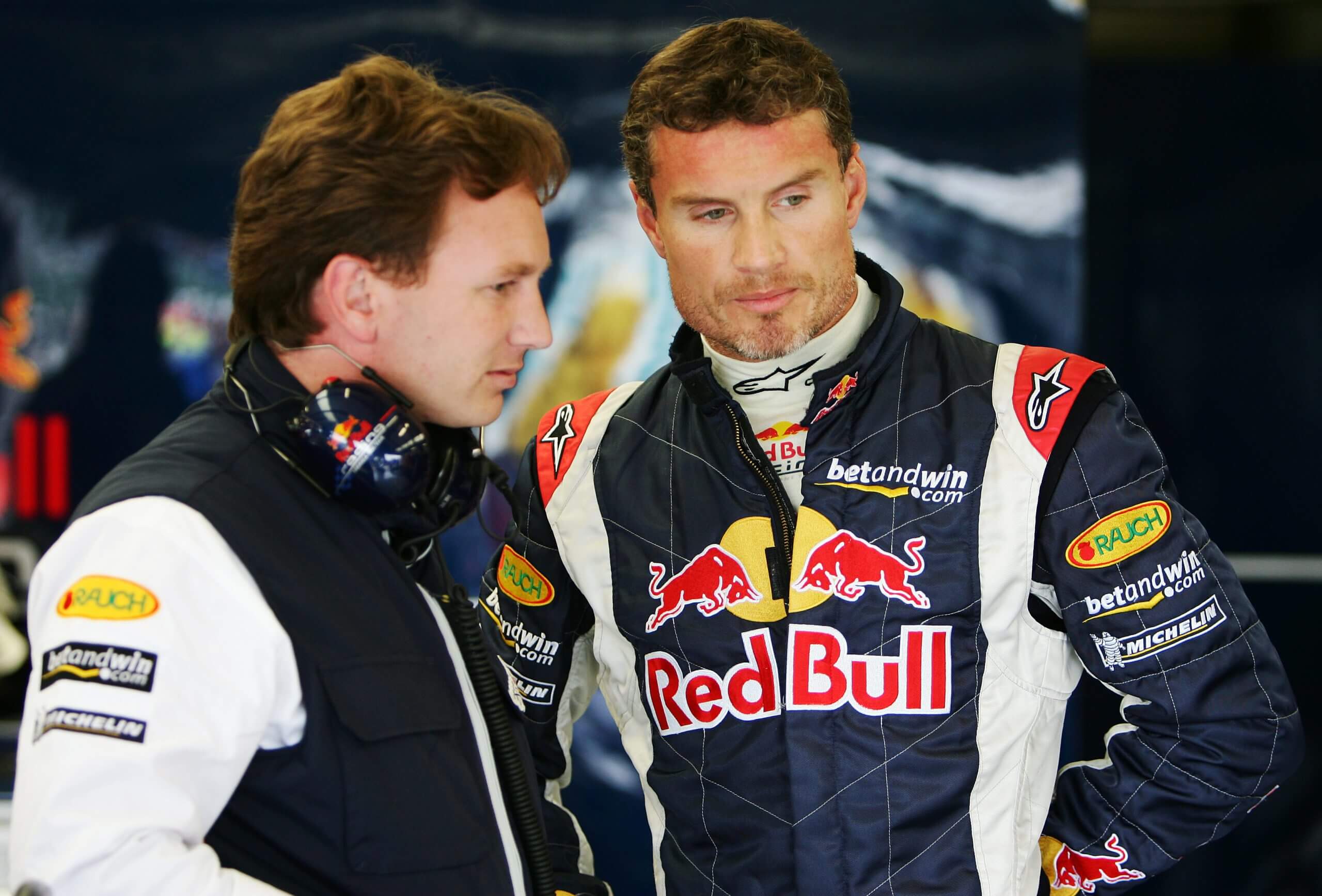
David Coulthard (R) and Christian Horner at the British Grand Prix on July 8, 2005. (Mark Thompson / Getty Images)
That year set Red Bull up for its first championship success in 2010, clinching the constructors’ title at the penultimate race in Brazil. Vettel then snared the drivers’ crown away from Webber and Ferrari rival Fernando Alonso at a tense finale in Abu Dhabi, becoming the youngest world champion in F1 history in the process. In six years, Horner had taken Red Bull from a £1 fire sale to double world champions.
Then came the true domination. In 2011, Newey’s RB7 proved difficult to beat with Vettel at the wheel as he swept to a second title, winning 11 out of 19 races. He pipped Alonso to the championship in 2012 before delivering even greater domination in 2013 with 13 wins, including a record-equalling stretch of nine on the bounce to close out the season. In four years, Red Bull had swept the championships.
Red Bull’s domination of F1 came to a sudden halt in 2014. Mercedes emerged as the superior team, armed with the best power unit in the field for the start of the V6 hybrid era, while Red Bull’s Renault engine simply wasn’t up to par. It would set the tone for an uneasy remainder of the partnership between Red Bull and Renault, who would ultimately split at the end of 2018.
Off the track, Horner was experiencing big personal change as his relationship with Halliwell became public in 2014. They were engaged by the end of the year and married the next year. Their son, Monty, was born in 2017, with each having one child from their previous marriages.
In 2014, there was an introduction to another figure who would come to play a key role in Horner’s future: 16-year-old Max Verstappen.
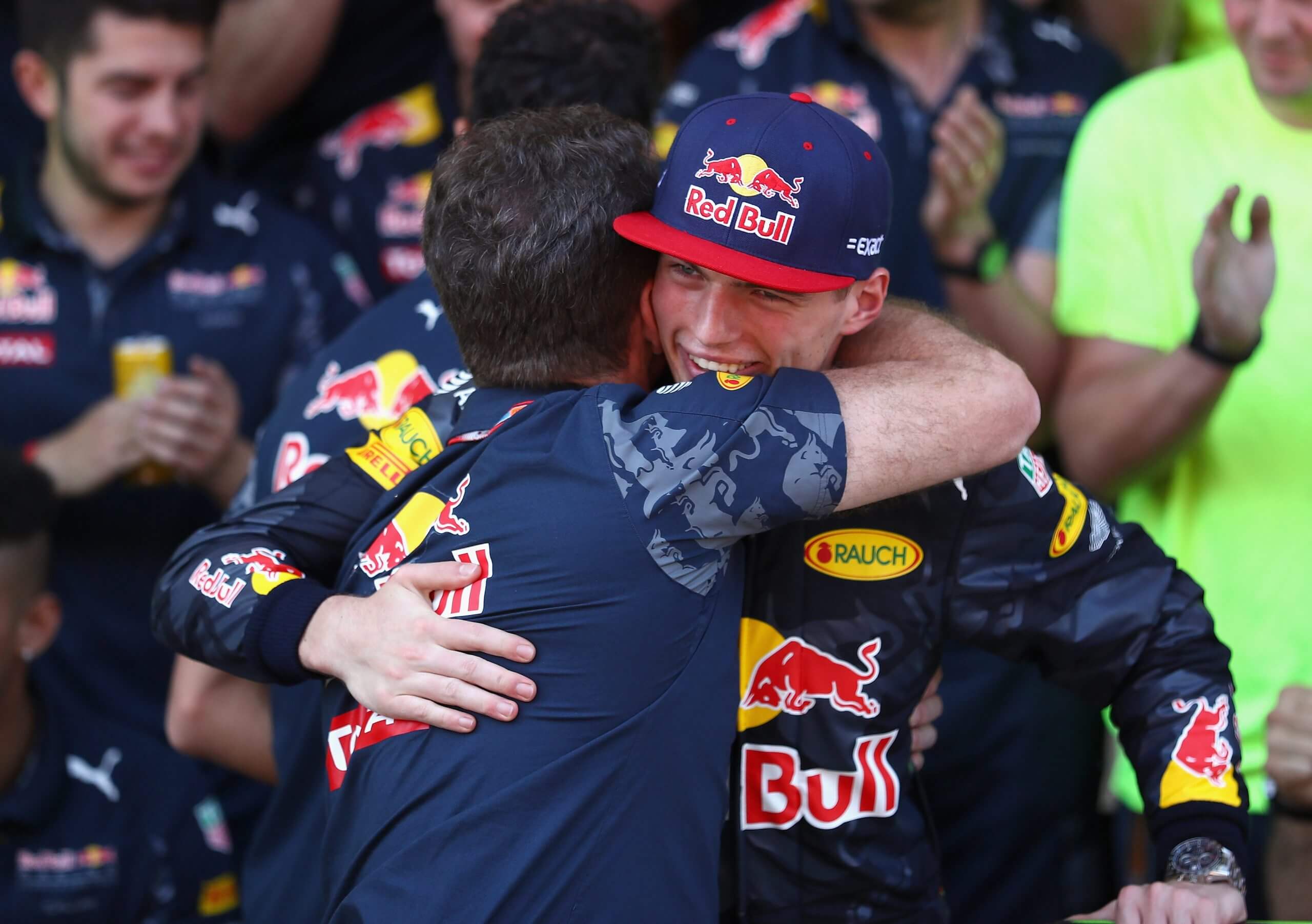
Christian Horner congratulates Max Verstappen after his first F1 win. (Clive Mason / Getty Images)
A precocious talent in go-karting, it was clear Verstappen had the makings of something special, leading to a race for his signature.
Talks to sign Verstappen to the Red Bull program were led by Marko, who could offer the Dutchman and his father, Jos, something no other F1 team could: an F1 seat with Toro Rosso for 2015, by which point he’d be just 17 and have a single year of car racing to his name, and not even a drivers’ license.
Mercedes boss Toto Wolff, who had planned to put Verstappen in GP2 (now F2), told him to take Red Bull’s offer.
Just over one year after becoming the youngest driver in F1 history when debuting for Toro Rosso, Verstappen was parachuted into one of Horner’s Red Bull cars, replacing the struggling Daniil Kvyat only four races into the 2016 season.
After the dominant Mercedes cars collided on the first lap, Verstappen ran a perfect race to win on debut for Red Bull in Spain; a first taste of what was to come, a streak of championships following from 2021 to 2024.
“Max has been the revelation,” Horner told The Athletic last year. “He’s been an immense part of our history.”
The intensity of the 2021 championship fight between Verstappen and Lewis Hamilton put Horner in the spotlight as the barbs exchanged between Horner and Mercedes counterpart Wolff fueled the news cycle for months.
The year ended in controversial fashion in Abu Dhabi. A fumbling of the rule book by race director Michael Masi — human error, it was later ruled — meant Verstappen could overtake Hamilton on the final lap of a race that should have never restarted, giving him a first world championship. For the first time in seven years, Horner and Red Bull had a title to celebrate. More would follow as the team emerged dominant under the new regulations for 2022.
Red Bull won 21 out of 22 races in 2023, Verstappen scoring 19 of them — both F1 records — and looked ready to dominate the F1 world for years to come with Horner at the helm. He was its public face in each episode of “Drive to Survive,” with greater airtime than many of his counterparts, and rarely far away from a Sky Sports interview on a race weekend.
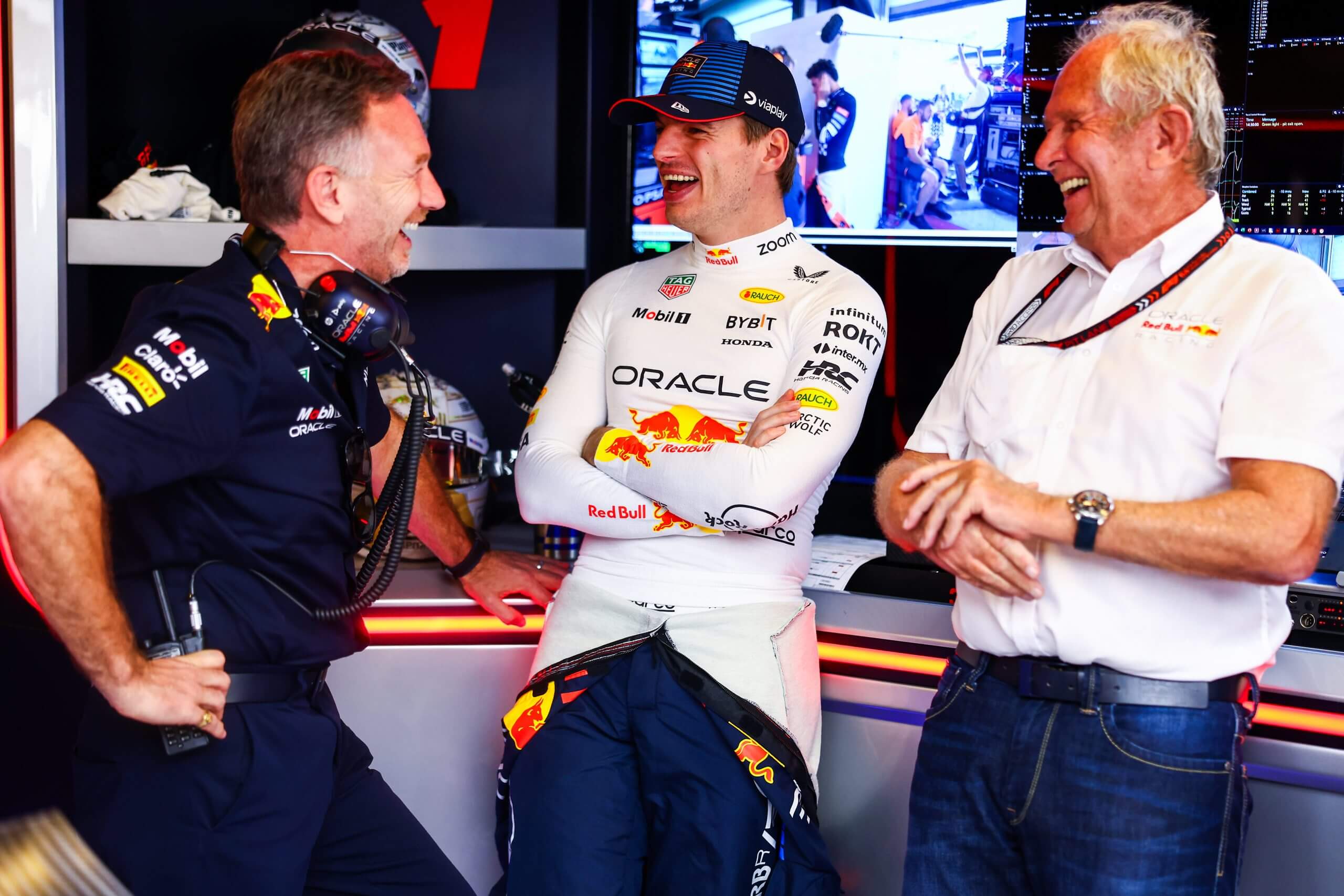
Christian Horner, Max Verstappen and Dr Helmut Marko (R) in the garage during final practice ahead of last year’s Abu Dhabi Grand Prix. (Mark Thompson / Getty Images)
Red Bull Racing was very much under Horner’s command and incredibly supportive of his leadership, leading to a united front even when it faced scrutiny, such as when the team was found to have breached F1’s budget cap in 2021, resulting in a $7million fine that Horner called “draconian.” Rival teams felt it was a slap on the wrist.
But behind the scenes, changes were occurring that would ultimately lead to Horner’s downfall a few years later.
The death of Mateschitz, who always supported Horner, in October 2022 was a major shift in the political landscape at Red Bull Racing. It led to changes within the Austrian side of the company, which held 49 percent of shares, sparking greater friction.
Tensions also emerged between Horner and Marko, with the latter proving difficult to rein in as he was not technically an employee of Red Bull Racing and therefore not answerable to Horner.
The public spotlight that Horner existed within also meant that in February 2024, when allegations of controlling and inappropriate behavior were made against him by a female employee, the news hit both front and back pages.
Horner always denied the allegations and the grievance was dismissed after an internal investigation overseen by a King’s Counsel. One day later, a cache of unverified messages and photos purported to be sent by Horner was anonymously sent to prominent members of the F1 paddock and the international media. Horner refused to comment on them and was joined by his wife for the race two days later in Bahrain. An appeal of the investigation’s findings was dismissed later in the year.
The scandal laid bare the cracks within Red Bull. Verstappen’s father, Jos, warned the team would be “torn apart” if Horner stayed in charge, while Max himself deflected opportunities to publicly back his team principal, only stating his desire for a calm environment.
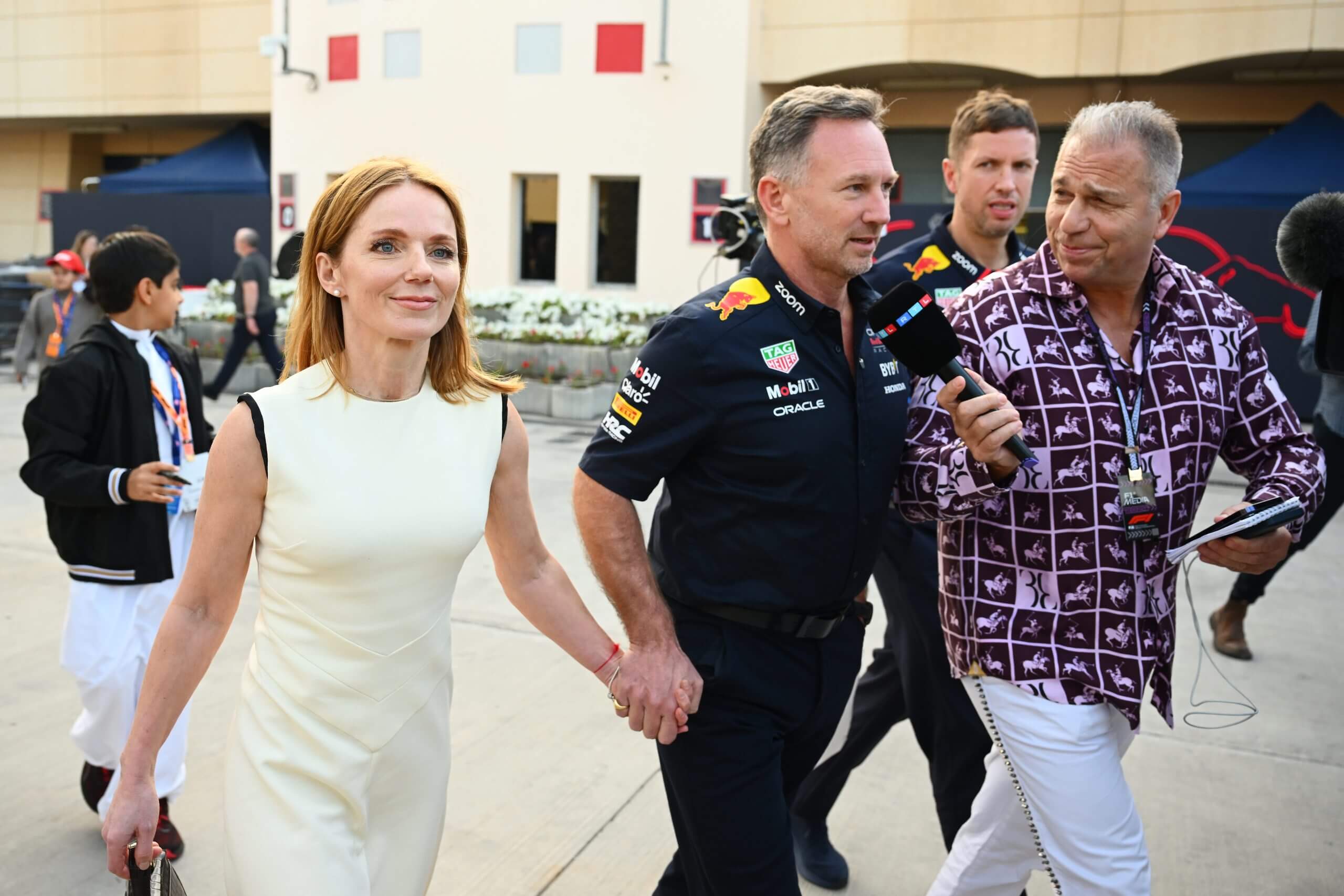
Geri and Christian Horner walk in the paddock before the Bahrain Grand Prix. (Clive Mason / Getty Images)
An uneasy peace persisted as Horner kept his position and the team kept performing on the track.
But a string of senior departures behind the scenes were taking away many of the foundations upon which Horner had built the Red Bull team. First came Rob Marshall in 2023, joining McLaren. Then, most significantly, Newey, who quit last May after 19 years and moved to Aston Martin. Sporting director Jonathan Wheatley followed suit to become team principal at Sauber. Will Courtenay, Red Bull’s head of strategy, is currently on gardening leave before a move to McLaren next year.
Horner always stressed these exits were manageable, hailing Red Bull’s strength in depth, and emphasizing the work being done to build the first Red Bull F1 engine in collaboration with Ford that will debut in 2026. Not only was he the F1 team boss, but he also served as the CEO of Red Bull Powertrains, the company’s power unit manufacturer, and had a reach into matters with Racing Bulls, the junior team. A lot of power for one person.
But amid Red Bull’s downturn in on-track performance this season, leaving Verstappen’s hopes of a fifth straight title already in tatters and his future in doubt, as well as an inability to have consistent performance from both of its cars for the best part of seven years, the questions started growing louder and louder.
Loud enough until, for the shareholders, there was only one answer. Horner had to leave.
After a turbulent 18 months in both his personal and professional life, an immediate return to F1’s frontlines would seem unlikely, this now giving him a moment to pause and collect himself.
As Horner noted in his farewell speech to Red Bull staff at the team’s headquarters in the English town of Milton Keynes on Wednesday, he remains employed by the company for now, with negotiations set to follow about the terms of his departure. His contract, worth in the region of $15million per year, ran through to the end of the decade.
Horner’s experience and profile mean he is certain to be on the radar for any F1 teams searching for a team principal in the future. A report in Germany last month linked him with a move to Ferrari as a replacement for Fred Vasseur, whose contract is up at the end of the year. Horner knocked back the suggestion by stressing his commitment to Red Bull Racing.
He is also on good terms with Alpine executive advisor and de facto chief Flavio Briatore, who is overseeing the latest in a long line of rebuilds of the Renault-owned team. One of Horner’s old Highland Terriers was called Flavio, the other being Bernie, after former F1 supremo Bernie Ecclestone.
For now, Horner will be left to digest his shock departure and reflect on a career with a team whose owners, in the end, decided they would be better off going forward without him.
(Top photo: Clive Mason/Getty Images)

